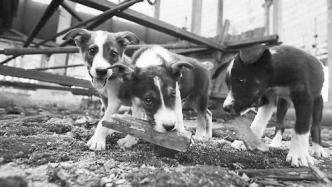

A group of stray puppies play in the deserted Chernobyl nuclear power plant. Credit: Sean Gallup/Getty
In the early morning of April 26, 1986, the residents of Chernobyl in the Soviet Union were sleeping, and they were awakened by a sudden loud noise—the No. 4 reactor of the Chernobyl nuclear power plant exploded. Successive explosions caused raging fires, and large amounts of radioactive material were sprayed into the air.
People around the accident site had to evacuate urgently, and many pets were abandoned in the panic. Days after the accident, rescuers searched for and exterminated the abandoned stray dogs to prevent the spread of radioactivity.
However, a study published March 3 in Science Advances shows that some of the dogs survived the roundup and reproduced, and many of the feral dogs that live near the plant today are their descendants.
In the first genetic study of large mammals from the area around Chernobyl, scientists collected DNA from wild dogs that lived near the nuclear power plant and found that some of them were descendants of dogs left behind after the accident, as well as Some are descendants of dogs who settled here shortly after the accident.
The research is the first step in a larger project to determine how dogs are adapting to survive in one of the most radioactive places on Earth. The researchers hope to use the information gained to better understand the effects of long-term radiation exposure on human genetics and health.
"We learn a lot from these animals. What happens when generations of large mammals live in such harsh environments? This is a once-in-a-lifetime opportunity to understand this." Elaine Ostrander, a geneticist at the Institute of Health, said.
The immediate impact of the Chernobyl accident is evident. According to the statistics of the World Health Organization, within a few months after the accident, about 30 power station workers and firefighters who participated in the evacuation and rescue after the explosion died of radiation poisoning. The pine trees around the accident site withered, and many insects came from Disappeared in this land full of radioactive elements.
But not much is known about the effects of low-level radioactive material years after the accident. Only a few studies have reported unusually high rates of genetic mutations in swallows and fruit flies near reactors. The reactors are now buried in a reinforced concrete sarcophagus. In addition, the debate about the health effects of low radiation has been intense.
Knowing this is important because people are likely to be in environments with low levels of radiation, such as having certain medical scans or working at a nuclear power plant. That's what motivated study co-author Timothy Mousseau, an evolutionary ecologist at the University of South Carolina, to conduct the study.
In 2017, Mousseau joined a volunteer project that provides medical care to hundreds of stray dogs living in the Chernobyl exclusion zone, the 2,600-square-kilometer area surrounding the power station.
During the 3 years of working in the area, Mousseau and colleagues collected blood samples from about 300 dogs that lived at the nuclear plant and nearby (mostly unoccupied) areas.
DNA analysis of the dogs showed that they were not new arrivals. By comparing the genes of other stray dogs in Eastern Europe, the researchers found that the dogs near the nuclear power plant had been isolated from other dog populations for decades.
The explosion deposited the deadly radioactive isotope cesium-137 near the plant in concentrations between 10 and 400 times that of the city of Chernobyl, 15 kilometers away. According to Ostrander, the persistence of the dogs in the area shows that they can survive and reproduce normally even near the reactor, which is "remarkable".
DNA samples from dogs are "incredibly valuable" because they tend to share spaces and diets with humans, Ostrander noted. But it's not easy to figure out which genetic changes in dogs are caused by radiation and which are caused by other factors, such as inbreeding or non-radioactive contamination. Mousseau plans to sample again this June.
Related paper information:
https://doi.org/10.1126/sciadv.ade2537
(The original title was "What happened to the "dogs" of Chernobyl? Scientists conducted the first genetic study of large mammals in the surrounding area")